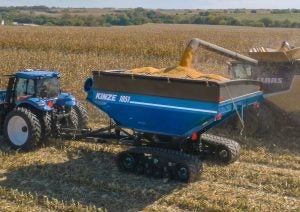Harvest season is quickly approaching, and Grandpa’s old adage rings as true as ever: an ounce of prevention is worth a pound of cure. Grain-cart manufacturer Kinze is offering nine maintenance recommendations to help get any grain cart field-ready for fall — even the old ones.
“The grain cart is a hard-working piece of equipment, so you’ll want to be sure it’s in good operating order before the combines roll,” said Justin Render, Kinze senior product specialist.
- Cart wheel maintenance
A walkaround is where many farmers start out equipment checks, and Kinze recommends nothing less. Check tire air pressure, and wheel bearings. Lubricate and repack bearings as necessary. Reset the torque on wheel nuts and check your tire pressure, if there are any loose nuts, check the rims and studs to be sure there’s no damage.
- Check your tracks
For models with tracks, check track alignment using steps listed in the operator’s manual. Adjust belt tension if needed to ensure that tracks will wear evenly. Double-check and lubricate bogies, and make sure axle bolts are not worn or cracked. Perform a visual inspection of the main track frame for damages and cracks.
- Repair or replace worn driveline components
This includes any gears, shafts, and gear boxes on your model. Check hydraulic hoses and connectors to ensure they’re properly fitted and free of visible wear and leaks. In addition, check the gearbox oil level to determine if it needs replacement.
- Repair or replace worn auger parts
Auger diameter will decrease over time, diminishing their overall performance. Grain transition areas are high wear areas. Wear and tear on these parts will cause slow upload times and extra strain on other driveline components. To avoid these holdu-s, inspect for wear where grain transitions from the horizontal to vertical auger or from the lower to upper vertical auger.
- Make sure lubrication points are functional and greased
Before you hit the fields, check track wheels, auger hinge areas, PTO vertical auger bearing, and other lubrication points. Inspect the gearbox oil level and condition – replace if needed. If your gearbox is run by chains, check the chain condition and lubrication.
- Properly align and adjust PTO/drive belts
Check to ensure that these parts are adequately greased, adjusted, and aligned. Inspect for heavy cracks, grooves, or other visible damage and ensure linkage is free to move, engaging and disengaging smoothly.
- Inspect the cart body
Whether using a manual or electric tarp, check for any tear or wear spots, ensuring that the tarp rolls freely with proper tension when closed. Models with electric tarps will need a power cable check and confirmation that everything, including the remote. is in working order. Look for any cracks in the cart side panels or frame and check that scales are in good condition and properly calibrated. Finally, inspect harnesses for any wear spots or damage from the previous season.
- Check scale accuracy
Calibrate per your owner’s manual by checking the cart weight of at least five different loads with legal for trade scale. Inspect all wires for damage and routing to prevent further damage in the field.
- Safety up before you hit the fields
Check safety chains, draw bar hitch pins, and clevis hitch to ensure they’re not bent or broken. Confirm that all lighting, including turn signals and flashers, are working properly and slow-moving vehicle signs are in good shape. Replace anything that doesn’t work. Ensure that power shaft guards are in place to cover the rotating drive shaft connecting the tractor and cart.



